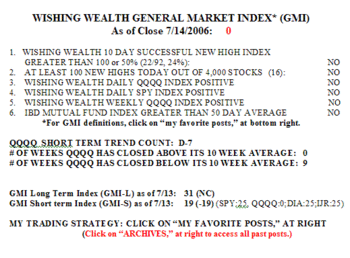The GMI is still at zero. There were 300 new lows and just 16 new highs on Friday. The last time we had more than 300 new lows (324) in my universe of 4,000 stocks was October 12, at a near term bottom. However, many of my indicators, while low, are not at extreme lows. For example, 14% of the Nasdaq 100 stocks closed above their 30 day average, compared with 9% on June 13.  The GMI-S is now at 19, reflecting weakness in almost all of my short term indicators for the four major stock indexes. The GMI-L is only a little better, at 31. 21-27% of the stocks in the Nasdaq 100, S&P 500 and Dow 30 indexes advanced on Friday. Friday was the seventh day (D-7) in the current QQQQ down-trend and the ninth week that the QQQQ has closed below its 10 week average. The IBD mutual fund index is below both its 50 day and 200 day moving averages and the 50 day is close to crossing below the 200 day. Thus, the professional growth fund managers are suffering in this market, another indication to stay away from growth stocks now.
The GMI-S is now at 19, reflecting weakness in almost all of my short term indicators for the four major stock indexes. The GMI-L is only a little better, at 31. 21-27% of the stocks in the Nasdaq 100, S&P 500 and Dow 30 indexes advanced on Friday. Friday was the seventh day (D-7) in the current QQQQ down-trend and the ninth week that the QQQQ has closed below its 10 week average. The IBD mutual fund index is below both its 50 day and 200 day moving averages and the 50 day is close to crossing below the 200 day. Thus, the professional growth fund managers are suffering in this market, another indication to stay away from growth stocks now.
The IBD 100 stocks continue to be slaughtered.  I think that the way IBD tracks the performance of the IBD 100 is very misleading because they keep replacing underperforming stocks with better performing stocks. When you look at the performance of the IBD 100 list published on a particular date (5/15) we get a more accurate indication of how these types of stocks have performed. Since 5/15, only 19% of the IBD 100 stocks have advanced, compared with 27% of the 4,000 stocks in my universe. Only 26-27% of the stocks in each group closed above their 10 week averages. None of the IBD 100 stocks and less than 1% of my universe of stocks hit a new high on Friday. Need any more evidence that growth stocks have been a dismal investment since mid-May?
I think that the way IBD tracks the performance of the IBD 100 is very misleading because they keep replacing underperforming stocks with better performing stocks. When you look at the performance of the IBD 100 list published on a particular date (5/15) we get a more accurate indication of how these types of stocks have performed. Since 5/15, only 19% of the IBD 100 stocks have advanced, compared with 27% of the 4,000 stocks in my universe. Only 26-27% of the stocks in each group closed above their 10 week averages. None of the IBD 100 stocks and less than 1% of my universe of stocks hit a new high on Friday. Need any more evidence that growth stocks have been a dismal investment since mid-May?
I am 100% in cash now, given my coming vacation. Since mid-May it has been almost too easy to trade profitably on the short side. Buying deep in the money puts in my IRA has been a wonderful strategy for this market. I urge all readers to get a copy of O’Neil’s book on shorting and to study the charts. A current scan of the market using TC2005 yields 7 rocket stocks and 422 submarines. Riding submarines down or staying in cash has been the best way for me to ride out the current market. With Fidelity Cash Reserves paying me about 4.8% for the cash balance in my account, it is nice to be on the sidelines. What is your brokerage firm paying you for your cash balances? You may be surprised/disappointed……….
Please send your comments to: silentknight@wishingwealthblog.com.

